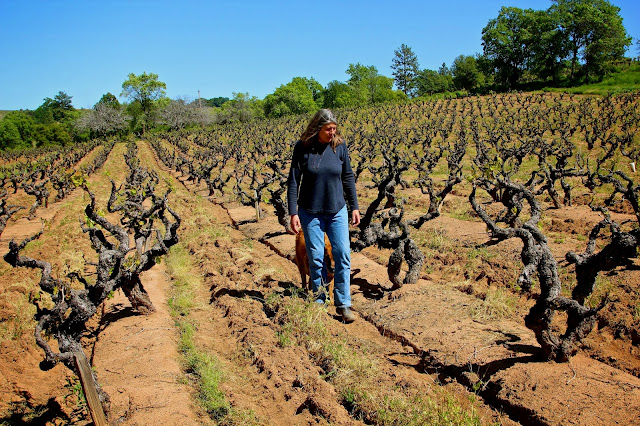Organic wine & food matching: Neal Cabernet Sauvignon & braised lamb with mint gremolata
 “When I told my dad we were going to take the company organic,” says Mark Neal, “he drove over to Sonoma and came back with a tray of rotten apples and peaches and said, ‘this is how our grapes will look when you grow organic.’”
“When I told my dad we were going to take the company organic,” says Mark Neal, “he drove over to Sonoma and came back with a tray of rotten apples and peaches and said, ‘this is how our grapes will look when you grow organic.’”Not to be dissuaded, Mark initiated the transition of vineyards owned or managed by Jack Neal & Son – established in 1968, and at nearly 1,900 acres, the largest single vineyard management company in Napa Valley – from conventional to organic grape growing in 1984. Jack Neal passed away in 1994, but not before seeing most of their vineyards accredited by California Certified Organic Farmers (i.e. CCOF) by 1991.
Today, with over 1,800 acres of vineyards fully certified, Jack Neal & Son is by far the largest grower of organic wine grapes in Napa Valley. About 1% of these grapes go into wines bottled under the family’s own label, Neal Family Vineyards (the winery established on Howell Mountain in 2001). Otherwise, the Neals work vineyards for no less than 60 growers, supplying grapes to some 72 wineries.
The sheer size of the Neals’ operation begs the questions: can any vineyard in Napa Valley be farmed organically; and if so, why not? AppellationAmerican.com currently puts the total acreage of grapes planted in the Napa Valley AVA at 43,000; just over 7% of which now has some sort of organic or Biodynamic® certification. “I honestly don’t know exactly why more growers in Napa Valley aren’t organic,” says Neal. It can’t be the cost, because when Mark Neal tracked eight of his vineyards transitioning from conventional to organic farming between 2005 and 2008, he found that “in seven of the eight ranches, the costs of organic farming were lower than conventional farming by an average of $6,000… the ‘high cost’ of organic farming is a myth.”
 Like others, Mark Neal was motivated early on simply because “I found the idea of synthetic, possibly harmful residue on grapes and vines unsavory… it’s always been a health concern for my family and for our employees. But really, organic is also simply better for the environment, and I don’t think that on the whole there is any argument over the fact that organic practices tend to enhance the inherent and distinctive aspect of vineyards.”
Like others, Mark Neal was motivated early on simply because “I found the idea of synthetic, possibly harmful residue on grapes and vines unsavory… it’s always been a health concern for my family and for our employees. But really, organic is also simply better for the environment, and I don’t think that on the whole there is any argument over the fact that organic practices tend to enhance the inherent and distinctive aspect of vineyards.”“Like organic foods,” says Neal, “organically grown wines simply taste better, which is why French organic wines, for example, show up consistently among the top ten best wines in any region, being cited in magazines as the most innovative, interesting and personalized products around.”
The Neals produce elegantly scaled Sauvignon Blanc, Zinfandel, and Petite Sirah, but their true forté is Cabernet Sauvignon, which are world class across the board. Among their stable of seven Cabernet Sauvignons are two each carrying Howell Mountain and Napa Valley AVAs, and one each from Rutherford, Mount Veeder, and Atlas Peak. Our Organic Wine Match of the Day, the 2005 Neal Family, Napa Valley Cabernet Sauvignon (about $45), is a modern day 100% varietal classic: a seamless, velvet textured blend of Howell Mountain, Rutherford, Atlas Peak and Mount Veeder grown fruit. The feel of the wine is thick and viscous, with layerings of sweet black fruit, cedar and peppermint, tinged with smoky, pungent, mocha espresso-like qualities.
 There are few things that go as naturally with a smooth Napa Valley style Cabernet Sauvignon like the Neals’ as lamb and mint; since both gamey and green-leafy sensations mingle effortlessly with eucalyptus qualities inherent in the grape. Lamb is expensive, but a great resource for recipes utilizing lower priced cuts of meat is Molly Stevens’ All About Braising. Since you need to buy the book to reap Stevens’ wisdom, for now you might make do with this online recipe for braised lamb shanks with mint gremolata and spring vegetables provided by Bon Appétit. Enjoy!
There are few things that go as naturally with a smooth Napa Valley style Cabernet Sauvignon like the Neals’ as lamb and mint; since both gamey and green-leafy sensations mingle effortlessly with eucalyptus qualities inherent in the grape. Lamb is expensive, but a great resource for recipes utilizing lower priced cuts of meat is Molly Stevens’ All About Braising. Since you need to buy the book to reap Stevens’ wisdom, for now you might make do with this online recipe for braised lamb shanks with mint gremolata and spring vegetables provided by Bon Appétit. Enjoy!





Comments